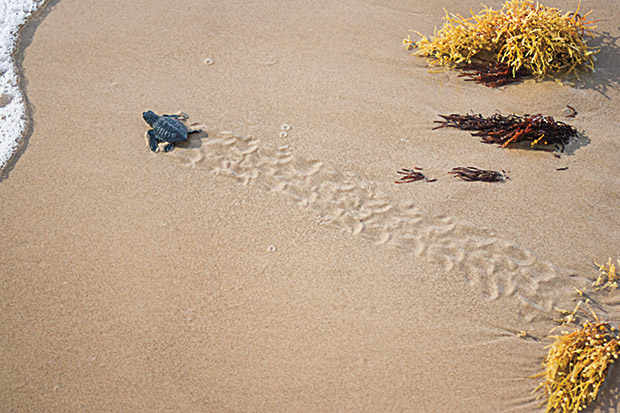
Kemps ridley sea turtles at Padre Island National Seashore. (Photo by Larry Ditto)

Kemps ridley sea turtles at Padre Island National Seashore. (Photo by Larry Ditto)
Texas is tailor-made for bucket lists. Covering some 268,000 square miles, the Lone Star State brims with interesting, exciting, historical, relaxing, and fun things to do and see. And considering Texas’ environmental and cultural diversity, the state lends itself to customized personal inventories of sights to see, thrills to experience and challenges to conquer.
Despite living in and traveling around Texas my entire life, I frequently encounter new additions to my Texas bucket list. At this rate, I’ll need to live at least 100 years.
To mark Texas Highways’ 42nd anniversary, we picked 42 of our favorites to create the quintessential Texas bucket list. If you keep your own tally, grab a pencil and get ready. If you don’t, well, what are you waiting for? We just made it easy, with these 42 must-dos before you’re through.
Float a Hill Country River
 In the heat of summer, nothing feels better than hopping into a big, inflatable tube and letting a cool river carry you away. I first experienced the time-honored tradition of “toobing” on the Llano River and later shared the fun with my children during regular trips down the scenic Frio River. In warm-weather months, multiple Frio River outfitters offer tube rentals and shuttle services for a variety of routes, many of them secluded. My favorite is the three-mile float through Garner State Park, beneath towering cypress trees, over limestone rapids, past gravel beaches, and through deep swimming holes. You can camp overnight and do it all over again next day.
In the heat of summer, nothing feels better than hopping into a big, inflatable tube and letting a cool river carry you away. I first experienced the time-honored tradition of “toobing” on the Llano River and later shared the fun with my children during regular trips down the scenic Frio River. In warm-weather months, multiple Frio River outfitters offer tube rentals and shuttle services for a variety of routes, many of them secluded. My favorite is the three-mile float through Garner State Park, beneath towering cypress trees, over limestone rapids, past gravel beaches, and through deep swimming holes. You can camp overnight and do it all over again next day.
The Medina River near Bandera offers another chilly, cypress-lined beauty of a float, typically lasting between 45 minutes and four hours—all without the crowds sometimes found on other rivers. Near Martindale, Don’s Fish Camp rents tubes and runs a fleet of school buses ferrying tubers for three-hour floats on the pecan- and oak-shaded San Marcos River. And in the New Braunfels area, join the summer revelry on the Guadalupe River, home to multiple outfitters. Don’t mess with Texas—pack out all your trash!
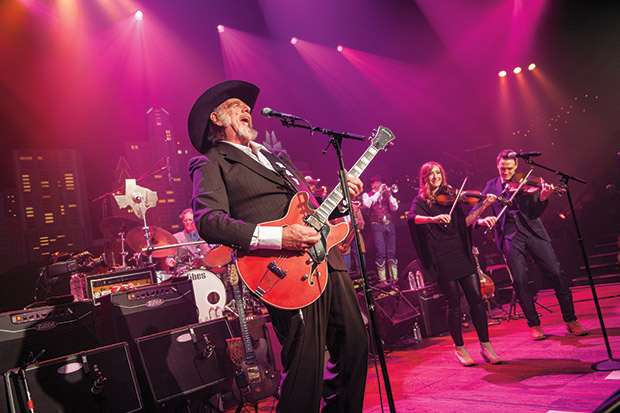
(Photo © Courtesy KLRU/Austin City Limits. Photo by Scott Newton)
Rock out at an Austin City Limits taping

(Photo © Courtesy KLRU/Austin City Limits. Photo by Scott Newton)
 At Austin’s 2,700-seat Moody Theater, banks of colored lights illuminate a stage jammed with musical instruments beneath the iconic, stylized rendering of the downtown Austin skyline. People pack the floor in front of the stage and fill rows of chairs as an animated buzz of anticipation fills the air.
At Austin’s 2,700-seat Moody Theater, banks of colored lights illuminate a stage jammed with musical instruments beneath the iconic, stylized rendering of the downtown Austin skyline. People pack the floor in front of the stage and fill rows of chairs as an animated buzz of anticipation fills the air.
Welcome to Austin City Limits, the longest-running music series in American television. Austin public television station KLRU-TV created the show in 1974, and today it broadcasts on dozens of stations across the country. Music fans who attended free tapings as college students now bring their grown children and even grandchildren to see performances from a diverse cast of artists, ranging from Willie Nelson (who performed on the show’s pilot) and Asleep at the Wheel (above) to Leon Bridges and Pearl Jam.
While the broadcast is a special treat for music lovers, nothing compares to being here in person. The performances last two hours but are condensed to 57 minutes for the show, and the setting often brings out the best in performers.
You can’t buy a ticket, though; sign up for the ticket lottery online (www.acltv.com) and keep your fingers crossed.
Paddle Caddo Lake
 A maze of sloughs, bayous, and ponds, Caddo Lake covers some 26,800 acres in northeast Texas, averaging about nine feet in depth. This swampy body of water straddles the Texas-Louisiana state line and forms the centerpiece of Caddo Lake State Park, located on Big Cypress Bayou.
A maze of sloughs, bayous, and ponds, Caddo Lake covers some 26,800 acres in northeast Texas, averaging about nine feet in depth. This swampy body of water straddles the Texas-Louisiana state line and forms the centerpiece of Caddo Lake State Park, located on Big Cypress Bayou.
The park’s headquarters offers canoe and kayak rentals year-round and provides access to several Texas Parks and Wildlife paddling trails. Explore another world in the park’s quiet, tea-colored backwaters, stately bald cypress trees draped with Spanish moss, and floating lotus and lily pads.
Listen for the plop of turtles dropping into the water from their perches in the sun, and keep your eyes peeled for alligators, frogs, herons, kingfishers, and beaver. Bring along your fishing pole, too: The lake contains 71 species of fish, including crappie and bass. Remember that getting lost is a very real possibility—be sure to take a map and plenty of supplies, and pay attention to your surroundings.
Back on land, explore bottomland hardwood forests and upland forests of pine, oak, and hickory via almost three miles of trails. Watch for rare migratory birds such as red-eyed vireos, prothonotary warblers, and northern parulas.
The view from the San Jacinto Monument
 The San Jacinto Monument’s 489-foot-high observation floor takes in a broad swath of Texas’ past, present, and future. The tower gets its name from the legendary battleground below, where, on April 21, 1836, Texian rebels defeated Santa Anna’s Mexican army in the Battle of San Jacinto to clinch Texas independence.
The San Jacinto Monument’s 489-foot-high observation floor takes in a broad swath of Texas’ past, present, and future. The tower gets its name from the legendary battleground below, where, on April 21, 1836, Texian rebels defeated Santa Anna’s Mexican army in the Battle of San Jacinto to clinch Texas independence.
Also visible from the observation tower (which is accessible by elevator) is the Battleship Texas, a veteran of both World Wars. It now welcomes visitors as a state historic site. Beyond the battleship lies the Houston Ship Channel, one of the busiest channels in the world, always churning with international freighters. In the distance, the metropolis of Houston glints in the Gulf Coast sun.
Dive into more than 400 years of Texas history at the San Jacinto Museum of History, located in the base of the tower. The monument grounds also include a reflecting pool and a trail through native prairie, tidal marsh, and bottomland forest. Granite markers designate strategic points of the historic battle, including the locations of the Texian and Mexican camps and the advance by Texian forces.
Another noteworthy fact: The San Jacinto Monument stands a total of 567 feet tall, 12 feet higher than the Washington Monument in our nation’s capital.
Paddle the Brazos with Goodbye to a River
 In 1957, Texas writer John Graves paddled 175 miles down the Brazos River between Possum Kingdom Dam and Lake Whitney. An article he wrote about the journey became a book, Goodbye to a River, exploring the relationship between humans and nature and serving as something of a eulogy to a river Graves feared would soon be destroyed by additional dam projects. Accompanied by his dachshund, which he referred to as “the passenger,” Graves camped on sandbars and shores, and fished and hunted for his supper along the way.
In 1957, Texas writer John Graves paddled 175 miles down the Brazos River between Possum Kingdom Dam and Lake Whitney. An article he wrote about the journey became a book, Goodbye to a River, exploring the relationship between humans and nature and serving as something of a eulogy to a river Graves feared would soon be destroyed by additional dam projects. Accompanied by his dachshund, which he referred to as “the passenger,” Graves camped on sandbars and shores, and fished and hunted for his supper along the way.
The Brazos rises in Stonewall County and flows 840 miles, emptying into the Gulf of Mexico near Freeport. The waterway played a prominent role in early Texas history and once was navigable 250 miles up from the Gulf to the town of Washington, where the Republic of Texas declared its independence. Graves’ journey may run a bit long for most, but you can retrace portions of it.
Rochelle’s Canoe Rental in Graford offers trips from a half-day to a week on the Brazos below Possum Kingdom to US 180 just west of US 281. Although Graves didn’t continue downstream to Waco, you also can get a taste of paddling the Brazos in Waco on Texas Parks and Wildlife’s Bosque Bluffs and Brazos Bridges paddling trails.
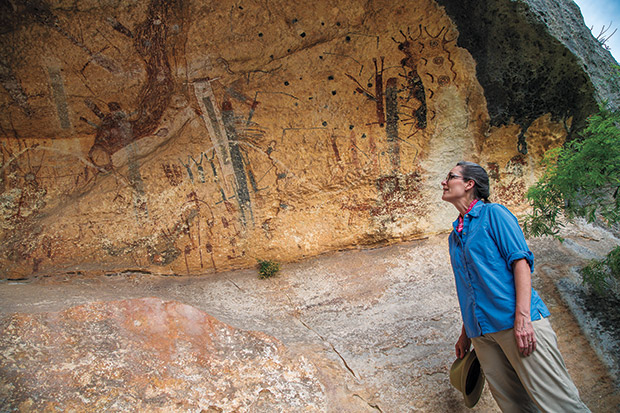
(Photo by Will van Overbeek)
Behold the rock art of the Lower Pecos Canyonlands

(Photo by Will van Overbeek)
 In southwest Texas, the Lower Pecos Canyonlands—formed by the Rio Grande, Devils, and Pecos rivers—provide a shady haven on the fringe of the Chihuahuan Desert. Thousands of years ago, hunter-gatherers lived in shelters among the canyons and decorated the rock walls with colorful paintings that represented their art, symbolism, and lifeways.
In southwest Texas, the Lower Pecos Canyonlands—formed by the Rio Grande, Devils, and Pecos rivers—provide a shady haven on the fringe of the Chihuahuan Desert. Thousands of years ago, hunter-gatherers lived in shelters among the canyons and decorated the rock walls with colorful paintings that represented their art, symbolism, and lifeways.
More than 2,000 archeological sites have been recorded in the region, including about 300 Lower Pecos pictograph sites within a 90-mile radius of the juncture of the Pecos River and Rio Grande.
Amistad National Recreation Area is home to two public sites to view rock paintings—Panther Cave and Parida Cave. Take a boat about 10 miles by water from the Pecos River boat ramp to Panther Cave, which overlooks the Rio Grande near its juncture with Seminole Canyon. Visitors are rewarded with hundreds of images and a spectacular red panther-like figure that stretches 10 feet. You can also see Panther Cave from the opposite cliff of Seminole Canyon within Seminole Canyon State Park. The overlook is part of the 7.5-mile round-trip Canyon Rim Trail (bring binoculars).
Feast on barbecue in Lockhart
 Humans have matched food with fire for millennia, but the smoking of meat didn’t achieve its highest potential until Texans set about perfecting the practice as barbecue. Resolutions from both the Texas House and Senate have declared the Central Texas town of Lockhart the official “Barbecue Capital of Texas.” Taste for yourself at one of four famous establishments.
Humans have matched food with fire for millennia, but the smoking of meat didn’t achieve its highest potential until Texans set about perfecting the practice as barbecue. Resolutions from both the Texas House and Senate have declared the Central Texas town of Lockhart the official “Barbecue Capital of Texas.” Taste for yourself at one of four famous establishments.
Black’s BBQ, opened in 1932 and continuously owned by the same family longer than any ’cue joint in Texas, slow-smokes its meat over post oak with a simple rub. Nearby, the locally popular Chisholm Trail Barbecue’s cafeteria-style selection includes fajitas in addition to smoked sausage, brisket, ribs, turkey, and chicken.
Kreuz’s history is a bit more complicated: Charles Kreuz opened Kreuz Market on the town square in 1900. Employee Edgar “Smitty” Schmidt bought the business in 1948 and sold it to his sons Rick and Don in 1984. Rick moved the joint a few blocks north in 1999, taking along coals from the original pit. Pit boss Roy Perez smokes meat in the traditional German style, served with no sauce and no forks.
Meanwhile, Smitty’s daughter, Nina Schmidt Sells, opened Smitty’s Market in the original Kreuz Market building. Her son John Fullilove now keeps the tradition alive as pitmaster.
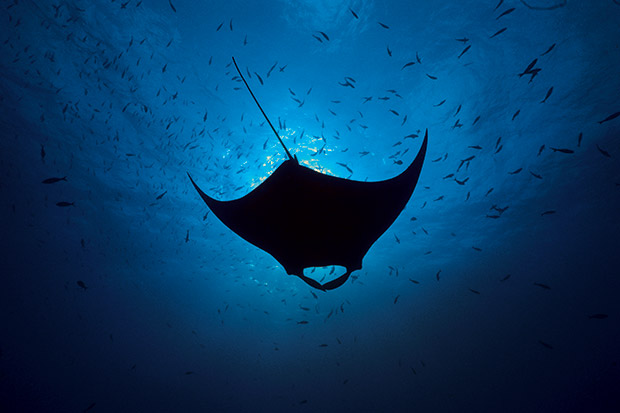
Flower Garden Banks. (Photo © Jose Cancelmo)
Scuba dive the Flower Garden Banks

Flower Garden Banks. (Photo © Jose Cancelmo)
 This national marine sanctuary protects the world’s northernmost coral reefs, located about 100 miles off the Texas coast. The Flower Garden Banks, which sit atop salt domes rising from the floor of the Gulf of Mexico, include three separate areas: East and West Flower Garden Banks, which are reef caps about 13 miles apart, and Stetson Bank, some 30 miles from the West bank. The ocean around the banks is 200 to 500 feet deep.
This national marine sanctuary protects the world’s northernmost coral reefs, located about 100 miles off the Texas coast. The Flower Garden Banks, which sit atop salt domes rising from the floor of the Gulf of Mexico, include three separate areas: East and West Flower Garden Banks, which are reef caps about 13 miles apart, and Stetson Bank, some 30 miles from the West bank. The ocean around the banks is 200 to 500 feet deep.
More than 20 species of hard coral form reefs populated by at least 280 species of fish—including colorful wrasse, parrotfish, and trunkfish—along with spiny lobster, sea urchins, eels, sea turtles, sharks, and manta rays. In summer, giant but gentle whale sharks arrive to feed on plankton, sometimes in large groups, and hammerhead sharks school around the reefs in spring. Divers rave about the abundance and diversity of marine life, the water’s deep-sea blue and incredible clarity, and the relative solitude.
Given the depth of the reefs, scuba diving is the only way to see them, and because of the distance from shore, a live-aboard dive boat is the best way to get there. Fling Charters out of Freeport has specialized in dive trips to the Flower Gardens for years.
Spray paint Cadillac Ranch
 In the early 1970s, an artist group known as the Ant Farm approached eccentric Amarillo millionaire Stanley Marsh 3 about funding their idea—10 Cadillacs half-buried in a field. Marsh reportedly expressed concern that the installation would be perceived as junk rather than art, but he funded the project anyway. Cadillac Ranch, created in 1974, now ranks as one of Amarillo’s biggest claims to fame.
In the early 1970s, an artist group known as the Ant Farm approached eccentric Amarillo millionaire Stanley Marsh 3 about funding their idea—10 Cadillacs half-buried in a field. Marsh reportedly expressed concern that the installation would be perceived as junk rather than art, but he funded the project anyway. Cadillac Ranch, created in 1974, now ranks as one of Amarillo’s biggest claims to fame.
The Cadillacs, including models from 1949 through 1964, are buried nose-down in a field, supposedly at the same angle as the Great Pyramid of Giza. People almost immediately began spray-painting the cars, which became part of the experience. Bring your own paint; the brighter the color, the better. Rumor has it the nearby Home Depot at Interstate 40 and Soncy Road sells more spray paint than any other
location. Just remember the old adage: Don’t, um, spray paint into the wind.
Cadillac Ranch is accessible at all times (no charge). Enter the field from the south access road of Interstate 40 just east of Arnot Road.
Straddle the Texarkana state line
 The circa-1933 Beaux Arts-style Federal Courthouse in Texarkana is the nation’s second-most photographed, behind only the U.S. Supreme Court Building in Washington, D.C. Such fame results from its status as the only federal building in the nation straddling a state line, the one between Texas and Arkansas.
The circa-1933 Beaux Arts-style Federal Courthouse in Texarkana is the nation’s second-most photographed, behind only the U.S. Supreme Court Building in Washington, D.C. Such fame results from its status as the only federal building in the nation straddling a state line, the one between Texas and Arkansas.
The federal government built the split courthouse intentionally, placing it in the center of State Line Avenue, which cuts north-south through Texarkana along the state boundary. In addition to two federal
courts and various federal offices, the building houses the only post office in the country without a home state.
Want to be two places at once? Find the prominent sign marking the state line on Photographer’s Island on the building’s south side. Here, you can put one foot in Texas and the other in Arkansas, or your feet in one state and your head in the other, yourself in Texas and your spouse in Arkansas—you get the idea.
Parking is readily available on the street around the area, with a variety of restaurants, museums, and other attractions nearby.
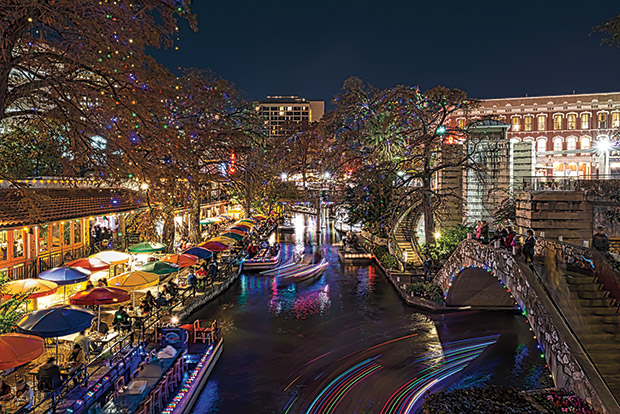
San Antonio River Walk at Christmas. (Photo by Cynthia Hestand)
Glow in the River Walk’s holiday sparkle

San Antonio River Walk at Christmas. (Photo by Cynthia Hestand)
 During the holidays, lights transform San Antonio’s River Walk into a magical esplanade ideal for a festive stroll. More than 2,000 luminarias illuminate the sidewalk along the 2.5-mile downtown section of the River Walk from dusk to dawn during the first three weekends in December. Overhead, more than 100,000 lights twinkle from towering trees from the day after Thanksgiving until just past New Year’s.
During the holidays, lights transform San Antonio’s River Walk into a magical esplanade ideal for a festive stroll. More than 2,000 luminarias illuminate the sidewalk along the 2.5-mile downtown section of the River Walk from dusk to dawn during the first three weekends in December. Overhead, more than 100,000 lights twinkle from towering trees from the day after Thanksgiving until just past New Year’s.
Beginning this year, says Paula Schechter of the Paseo del Rio Association, luminarias created with LED lights in waxed paper bags will replace the traditional Mexican Christmas lanterns made with candles nestled in sand inside paper bags. The electric versions will glow all night, rain or shine.
Amble among the lights or catch one of Rio San Antonio Cruises’ river tour boats and enjoy the spectacle from the water. Available at five stations including the Shops at Rivercenter, the boats operate daily until at least 9 p.m. Cap the evening with a hot drink in one of the many restaurants and bars along the river.
See the sea turtles
 Endangered Kemp’s ridley sea turtles nest primarily on beaches fronting the Gulf of Mexico, and Padre Island National Seashore is the best place in the United States to see them. To help bolster the population, the park keeps sea turtle eggs in a protected area, then releases hatchlings on the beach from mid-June through August. Some releases are open to the public, held at 6:45 a.m. on Malaquite Beach. Public releases only happen when compatible with hatchling needs, so for the best chance to see one, plan a visit of several days when multiple nests may hatch.
Endangered Kemp’s ridley sea turtles nest primarily on beaches fronting the Gulf of Mexico, and Padre Island National Seashore is the best place in the United States to see them. To help bolster the population, the park keeps sea turtle eggs in a protected area, then releases hatchlings on the beach from mid-June through August. Some releases are open to the public, held at 6:45 a.m. on Malaquite Beach. Public releases only happen when compatible with hatchling needs, so for the best chance to see one, plan a visit of several days when multiple nests may hatch.
Park rangers release hatchlings high up on the beach, re-creating how the little turtles would naturally crawl from a nest to the surf. This crawl allows the rangers to assess whether the turtles are ready to survive on their own, and also probably contributes to imprinting, a process where the brains of the baby turtles record unique characteristics of the beach. This makes it possible for female sea turtles to return many years later and from many miles away to lay their eggs on the same beach. It also happens to provide an opportunity for people to watch the tiny turtles’ mad scramble to the water.
Spot the whooping cranes

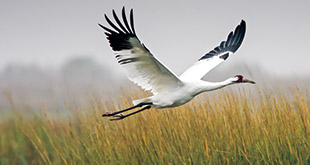
Whooping crane. (Photo by Larry Ditto)
Your best chance to see these majestic whoopers is at Aransas National Wildlife Refuge, where they winter from mid-October through March. All the wild and captive whooping cranes alive in the world today, in fact, descended from 15 cranes that wintered here in Texas in 1941.
The birds fly 2,500 miles from their nesting grounds in northern Canada’s Wood Buffalo National Park to the Texas coast, where they’re nourished by blue crabs, wolfberries, crawfish, frogs, large insects, and acorns for their long trip back to Canada.
The refuge’s Heron Flats Observation Deck provides a whooping crane vantage point. They also appear frequently at Goose Island State Park and the public road along St. Charles Bay in Rockport. Boat tours offer the best chance to see the birds up close, though. Guides in both Rockport and Port Aransas lead outings to see the birds.
The Wyler Aerial Tramway in El Paso
 Swiss-made, bright yellow gondolas board at an elevation of 4,692 feet in Franklin Mountains State Park and travel along a 2,600-foot-long steel cable to the top of Ranger Peak, elevation 5,632 feet. On the four-minute ride, the cars sway at a height of up to 240 feet above the ground and pass above 600 million years of geologic history, a variety of cacti, and wildlife such as mule deer.
Swiss-made, bright yellow gondolas board at an elevation of 4,692 feet in Franklin Mountains State Park and travel along a 2,600-foot-long steel cable to the top of Ranger Peak, elevation 5,632 feet. On the four-minute ride, the cars sway at a height of up to 240 feet above the ground and pass above 600 million years of geologic history, a variety of cacti, and wildlife such as mule deer.
You can see 7,000 square miles from the peak on a clear day, overlooking Texas, New Mexico, and Mexico all at once. The truly intrepid can hike to the peak instead.
The tramway opens Friday through Sunday and on major holidays.
Greasy-spoon enchiladas at H&H Car Wash
 Since 1958, El Pasoans have chowed down on homemade Tex-Mex at H&H Car Wash, leaving with full stomachs and clean cars. Syrian immigrant Najib Haddad came up with the winning idea of
Since 1958, El Pasoans have chowed down on homemade Tex-Mex at H&H Car Wash, leaving with full stomachs and clean cars. Syrian immigrant Najib Haddad came up with the winning idea of
combining a car wash with a café; his son Maynard now runs the establishment, and granddaughter Julie helps out. Order chicken enchiladas on Wednesday—chicken day—and cheese or beef on other days with homemade red sauce and an egg on top. On Fridays, you can get enchiladas with red or green sauce. H&H opens Monday through Saturday, 7 a.m.-3 p.m., at 701 E. Yandell Drive.
Polo on the Prairie in Albany
 When Mary Anne McCloud wanted to share her passion for the work done at MD Anderson Cancer Center in Houston, her son-in-law, Henry Musselman, suggested a polo tournament. Musselman built a polo field in a pasture on his family’s Lazy 3 Ranch in Albany, and in 1986, Polo on the Prairie began. Amateur and professional players now come from all over the world for the annual April match.
When Mary Anne McCloud wanted to share her passion for the work done at MD Anderson Cancer Center in Houston, her son-in-law, Henry Musselman, suggested a polo tournament. Musselman built a polo field in a pasture on his family’s Lazy 3 Ranch in Albany, and in 1986, Polo on the Prairie began. Amateur and professional players now come from all over the world for the annual April match.
No horse? No problem! Festivities also include barbecue, live music, and fireworks.
So far, the event has contributed nearly $6 million to cancer research and patient programs at MD Anderson.
The mysterious Marfa Lights
 After several unsuccessful earlier attempts, some years ago I took my two daughters to the Marfa Lights Viewing Area on US 90, nine miles east of town. Looking across the dark expanse of desert before us,
After several unsuccessful earlier attempts, some years ago I took my two daughters to the Marfa Lights Viewing Area on US 90, nine miles east of town. Looking across the dark expanse of desert before us,
I sputtered, “Someone built a house out there! Their porch lights ruin everything.” Then it hit me—I had just joined the club, those lucky visitors who have seen these random, distant, moving spots of glowing red, blue, or white. Recorded sightings of the mysterious lights date to the 19th Century. Their source, indeed their very existence, remains contentious, but come judge for yourself.
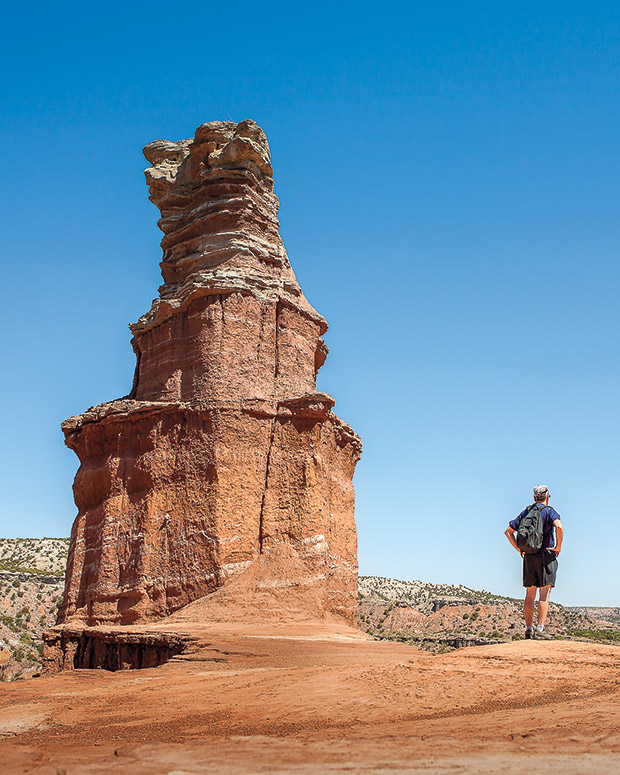
The Lighthouse at Palo Duro Canyon. (Photo © Kenny Braun)
The Lighthouse at Palo Duro Canyon

The Lighthouse at Palo Duro Canyon. (Photo © Kenny Braun)
 Palo Duro Canyon, the second-largest canyon in the United States, runs some 120 miles long, 20 miles wide, and 800 feet deep. Its walls reveal four geologic layers reaching back about 250 million years, exposed over time by the Red River’s Prairie Dog Town Fork.
Palo Duro Canyon, the second-largest canyon in the United States, runs some 120 miles long, 20 miles wide, and 800 feet deep. Its walls reveal four geologic layers reaching back about 250 million years, exposed over time by the Red River’s Prairie Dog Town Fork.
This park’s most iconic sight, a shale and sandstone pinnacle called The Lighthouse, rises 310 feet, formed by uneven erosion rates of different rock layers.
The 2.72-mile Lighthouse Trail passes colorful rock formations and crosses arroyos, ending at the base of the pinnacle. The final leg requires some serious scrambling.
Custom cowboy boots
 Texas citizenship practically requires a pair of cowboy boots, ideally custom-made. But ever-increasing demand means you need patience when ordering your custom pair.
Texas citizenship practically requires a pair of cowboy boots, ideally custom-made. But ever-increasing demand means you need patience when ordering your custom pair.
Today’s cowboy boots represent the refinement of 17th-Century English riding footwear. During the cattle-drive era, Texas was home to some of the country’s best-known bootmakers.
Custom bootmakers operate in every corner of the state, and costs vary widely. Expect to spend about an hour on a fitting, from measuring your feet to selecting leathers, colors, stitching style, heel, toe shape, and soles. Then you wait. It can take three months or longer for the bootmaker to complete your order. But it’s worth the wait—just ask anyone wearing a custom pair.
Raft Santa Elena Canyon
 One of the best ways to experience Big Bend National Park’s dramatic Santa Elena Canyon, a 17-mile gash in the massive Mesa de Anguila Mountains, is from the Rio Grande, the river that created it. Two-day trips can include camping at the canyon mouth beneath never-ending stars after a hearty supper, then floating between canyon walls that tower 1,500 feet overhead and running a few rapids, including the short-but-exciting Rock Slide. Outfitters provide gear and meals. Celebrate with margaritas at Terlingua’s Starlight Theatre Restaurant and hit the hay at La Posada Milagro Guesthouse next door. Visit National Park Services river trips page for rafting outfitters and river conditions.
One of the best ways to experience Big Bend National Park’s dramatic Santa Elena Canyon, a 17-mile gash in the massive Mesa de Anguila Mountains, is from the Rio Grande, the river that created it. Two-day trips can include camping at the canyon mouth beneath never-ending stars after a hearty supper, then floating between canyon walls that tower 1,500 feet overhead and running a few rapids, including the short-but-exciting Rock Slide. Outfitters provide gear and meals. Celebrate with margaritas at Terlingua’s Starlight Theatre Restaurant and hit the hay at La Posada Milagro Guesthouse next door. Visit National Park Services river trips page for rafting outfitters and river conditions.
Two-step in Luckenbach

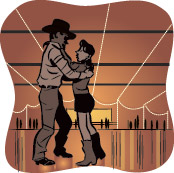 Ah, the Texas two-step; a simple yet engaging dance, easy to learn, but capable of complexity, depending on the dancer. And it fits, foot-in-boot, with most any country song.
Ah, the Texas two-step; a simple yet engaging dance, easy to learn, but capable of complexity, depending on the dancer. And it fits, foot-in-boot, with most any country song.
A lot of two-stepping happens in Luckenbach, the tiny Hill Country town with a legendary eponymous dance hall. Established in 1849, the town was acquired by Texas characters Hondo Crouch, Guich Koock,
and Kathy Morgan in 1971. In 1973, Jerry Jeff Walker recorded his album !Viva Terlingua! here. Four years later, Waylon Jennings and Willie Nelson’s song “Luckenbach, Texas (Back to the Basics of Love)” really put the hamlet on the map. The dance hall still hosts some of Texas’ best musicians, and if you haven’t two-stepped here, you haven’t really two-stepped.
Enchanted Rock sunrise
 Deep in the Texas Hill Country, Enchanted Rock’s pink granite dome covers 640 acres and rises 425 feet. Its size, elevation, and location make it the perfect place to watch the sunrise. Get to the Summit Trail when it opens 30 minutes before daylight, climb about halfway up, circle around counterclockwise until you are facing east, and enjoy. You’ll need to camp overnight at the park, and be sure to make note of sunrise times before you head out into the wilderness.
Deep in the Texas Hill Country, Enchanted Rock’s pink granite dome covers 640 acres and rises 425 feet. Its size, elevation, and location make it the perfect place to watch the sunrise. Get to the Summit Trail when it opens 30 minutes before daylight, climb about halfway up, circle around counterclockwise until you are facing east, and enjoy. You’ll need to camp overnight at the park, and be sure to make note of sunrise times before you head out into the wilderness.
Feed giraffes at the Houston Zoo
 The Houston Zoo’s Masai giraffes show a keen interest in the fresh lettuce offered up by visitors. Some of the long-necked animals, native to the wild in Tanzania and Kenya, politely take the lettuce with their lips. Others reach out with their 20-inch tongues, which can wrap around a morsel with ease. The zoo offers chances to feed the animals daily at 11 a.m. and 2 p.m., weather and giraffes permitting, from a shaded, giraffe-head-high platform. Feeding only takes a few minutes, leaving time to explore the rest of the zoo. Tickets for giraffe feedings, available at the Feeding Platform kiosk, cost $7.
The Houston Zoo’s Masai giraffes show a keen interest in the fresh lettuce offered up by visitors. Some of the long-necked animals, native to the wild in Tanzania and Kenya, politely take the lettuce with their lips. Others reach out with their 20-inch tongues, which can wrap around a morsel with ease. The zoo offers chances to feed the animals daily at 11 a.m. and 2 p.m., weather and giraffes permitting, from a shaded, giraffe-head-high platform. Feeding only takes a few minutes, leaving time to explore the rest of the zoo. Tickets for giraffe feedings, available at the Feeding Platform kiosk, cost $7.
The Saga light show
 San Fernando Cathedral, built between 1738 and 1755, ranks as the oldest operating sanctuary in North America and anchors San Antonio’s Main Plaza, one of only four colonial plazas remaining in the country. On certain nights, the cathedral’s intricate façade becomes the canvas for San Antonio | The Saga, a 24-minute projection of artwork and music designed by French artist Xavier de Richemont. The installation tells the complex and remarkable history of this part of Texas in a series of swirling, cascading figures, symbols, and faces in vibrant colors. Scheduled to show through 2024, The Saga takes place at 9, 9:30, and 10 on Tuesday, Friday, Saturday, and Sunday nights.
San Fernando Cathedral, built between 1738 and 1755, ranks as the oldest operating sanctuary in North America and anchors San Antonio’s Main Plaza, one of only four colonial plazas remaining in the country. On certain nights, the cathedral’s intricate façade becomes the canvas for San Antonio | The Saga, a 24-minute projection of artwork and music designed by French artist Xavier de Richemont. The installation tells the complex and remarkable history of this part of Texas in a series of swirling, cascading figures, symbols, and faces in vibrant colors. Scheduled to show through 2024, The Saga takes place at 9, 9:30, and 10 on Tuesday, Friday, Saturday, and Sunday nights.
The State Fair of Texas Ferris Wheel
 Fair Park in east Dallas has hosted the State Fair of Texas since 1905. When the Star Ferris Wheel debuted at the 1985 fair, it was the largest Ferris wheel in North America, and it still is the tallest in Texas. Hop into one of its 35 gondolas with up to five of your friends to enjoy a bird’s-eye view of the State Fair and the downtown Dallas skyline from the ride’s 212-foot peak—about 20 stories high. On clear days, you can see downtown Fort Worth, 40 miles away. At night, the wheel’s red, white, and blue lights spin in a lovely Lone Star blur.
Fair Park in east Dallas has hosted the State Fair of Texas since 1905. When the Star Ferris Wheel debuted at the 1985 fair, it was the largest Ferris wheel in North America, and it still is the tallest in Texas. Hop into one of its 35 gondolas with up to five of your friends to enjoy a bird’s-eye view of the State Fair and the downtown Dallas skyline from the ride’s 212-foot peak—about 20 stories high. On clear days, you can see downtown Fort Worth, 40 miles away. At night, the wheel’s red, white, and blue lights spin in a lovely Lone Star blur.
Take a selfie with Paris’ Eiffel Tower

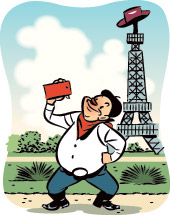
(Illustration by Mark Matcho)
The Paris tower stands 65 feet tall, located between this northeast Texas town’s civic center and the Red River Valley Veteran’s Memorial. Night is a great time for photos, when the tower lights up, or daytime when sunshine hits the tooled gold feather in the rim of the hat. Chances are that other tourists or friendly locals hanging around can snap a photo for you, or bring your friends and take a group picture.
Big Thicket National Preserve
 Forty miles of hiking trails explore the roughly 105,000 acres of the Big Thicket National Preserve, a patchwork of protected land and water corridor units in southeast Texas. The preserve is home to 85 species of trees, 60 shrubs, 26 ferns, 20 orchids, four carnivorous plants, 185 species of birds, and 50 reptiles.
Forty miles of hiking trails explore the roughly 105,000 acres of the Big Thicket National Preserve, a patchwork of protected land and water corridor units in southeast Texas. The preserve is home to 85 species of trees, 60 shrubs, 26 ferns, 20 orchids, four carnivorous plants, 185 species of birds, and 50 reptiles.
The 5.4-mile Woodlands Trail crosses Big Sandy Creek floodplain and a dense hardwood forest of sweet gum, oak, tupelo, and holly in low areas, with beech, magnolia, and pine higher up. The 1.5-mile Sundew Trail traverses wetland savannah, grasslands, and scattered pines—it’s a great location to see wildflowers in season and carnivorous pitcher and sundew plants.
Texas Motor Speedway
 Ever wonder what it feels like to hurtle around a NASCAR track like the pros? The Team Texas High Performance Driving School at the Texas Motor Speedway in Fort Worth offers the chance to experience the thrill in actual racecars at speeds of up to 160 miles per hour. Ride-alongs start at $125, and for prices starting at $270, you can actually take the wheel for five laps.
Ever wonder what it feels like to hurtle around a NASCAR track like the pros? The Team Texas High Performance Driving School at the Texas Motor Speedway in Fort Worth offers the chance to experience the thrill in actual racecars at speeds of up to 160 miles per hour. Ride-alongs start at $125, and for prices starting at $270, you can actually take the wheel for five laps.
If you’d rather stick to the bleachers or the infield, expect plenty of thrills in watching races, especially the NASCAR Sprint Cup Series events, held annually in April and November. The races reach speeds of up to 200 mph and routinely rank as the largest sporting events in Texas and among the largest single-day events in the country.
Fall foliage at Lost Maples State Park
 This park contains a magnificent stand of Uvalde Bigtooth Maples that, given the right conditions, blazes brilliant red shades in fall. On the Maple Trail along the Sabinal River, the red leaves pop against limestone cliffs and pale green water. Maples also grow along the West and East trails, where walnut, sycamore, and oaks add splashes of orange and yellow.
This park contains a magnificent stand of Uvalde Bigtooth Maples that, given the right conditions, blazes brilliant red shades in fall. On the Maple Trail along the Sabinal River, the red leaves pop against limestone cliffs and pale green water. Maples also grow along the West and East trails, where walnut, sycamore, and oaks add splashes of orange and yellow.
Peak season generally falls within the first two weeks of November. Check the online foliage report, and if possible, visit on a weekday to avoid waits of two to three hours to get into the park.
Play 42

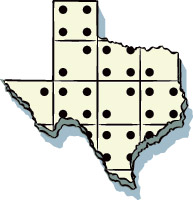 The first weekend in March, Hallettsville hosts the Texas State Championship “42” Domino Tournament, with warm-up games Friday night and qualifying on Saturday morning, followed by the big game. Not ready for intense competition? Round up three buddies and play for fun. Two pairs of teams face off in this bidding game and attempt to win the most points using a standard 28-piece domino set. Legend has it that two Parker County boys, ages 12 and 14, invented the game in 1887 after catching trouble for playing cards, which was taboo in their strict Baptist community. The Texas House designated 42 Texas’ official state domino game in 2011.
The first weekend in March, Hallettsville hosts the Texas State Championship “42” Domino Tournament, with warm-up games Friday night and qualifying on Saturday morning, followed by the big game. Not ready for intense competition? Round up three buddies and play for fun. Two pairs of teams face off in this bidding game and attempt to win the most points using a standard 28-piece domino set. Legend has it that two Parker County boys, ages 12 and 14, invented the game in 1887 after catching trouble for playing cards, which was taboo in their strict Baptist community. The Texas House designated 42 Texas’ official state domino game in 2011.
Hear the chachalaca’s song
 Half the fun of looking for chachalacas is simply saying their name. In the United States, the olive-brown Plain chachalaca, named for its loud, raucous call, lives only in the Lower Rio Grande Valley. And a great place to see (and hear) the birds is Bentsen-Rio Grande Valley State Park in Mission.
Half the fun of looking for chachalacas is simply saying their name. In the United States, the olive-brown Plain chachalaca, named for its loud, raucous call, lives only in the Lower Rio Grande Valley. And a great place to see (and hear) the birds is Bentsen-Rio Grande Valley State Park in Mission.
Located along major bird migration routes, the park has recorded sightings of more than 358 bird species, drawing birders from all over to see green jays, buff-bellied hummingbirds, great kiskadees, and Altamira orioles.
Chachalacas prefer thorny thickets, scrubland, and second-growth forest edges, where they feed on leaves, berries, and seeds. They fly only in short bursts so look for them running around on the ground and in the trees.
Dr Pepper floats!
 Celebrate this beloved Texas drink, invented by a Waco pharmacist in 1885, with a float made at the Dr Pepper Museum’s soda fountain in Waco. The only ingredients: handmade Dr Pepper—including cane sugar syrup and carbonated water—and Blue Bell Homemade Vanilla ice cream.
Celebrate this beloved Texas drink, invented by a Waco pharmacist in 1885, with a float made at the Dr Pepper Museum’s soda fountain in Waco. The only ingredients: handmade Dr Pepper—including cane sugar syrup and carbonated water—and Blue Bell Homemade Vanilla ice cream.
The Spoetzl Brewery
 The Spoetzl Brewery, which opened in Shiner in 1909 to serve the local Bohemian settlers, crafts every drop of Shiner beer, all dozen varieties, from White Wing Belgian White to the popular Shiner Bock. Complimentary tours and refreshments—we’ll drink to that!
The Spoetzl Brewery, which opened in Shiner in 1909 to serve the local Bohemian settlers, crafts every drop of Shiner beer, all dozen varieties, from White Wing Belgian White to the popular Shiner Bock. Complimentary tours and refreshments—we’ll drink to that!
Sixth Floor Museum
 Explore the tumultuous 1960s, the life of John F. Kennedy, and one of the darkest days in Texas history at the Texas School Book Depository’s Sixth Floor Museum in Dallas. On cell-phone narrated walking tours of Dealey Plaza, linger on the infamous grassy knoll.
Explore the tumultuous 1960s, the life of John F. Kennedy, and one of the darkest days in Texas history at the Texas School Book Depository’s Sixth Floor Museum in Dallas. On cell-phone narrated walking tours of Dealey Plaza, linger on the infamous grassy knoll.
The Spectacle of Bat Flights
 On summer evenings, millions of Mexican free-tailed bats emerge en masse from Texas caves for their nightly insect hunt. Catch this impressive sight at Austin’s Congress Avenue bridge or one of Texas’ many caverns, from Devil’s Sinkhole State Natural Area to Old Tunnel State Park.
On summer evenings, millions of Mexican free-tailed bats emerge en masse from Texas caves for their nightly insect hunt. Catch this impressive sight at Austin’s Congress Avenue bridge or one of Texas’ many caverns, from Devil’s Sinkhole State Natural Area to Old Tunnel State Park.
The Texas State Capitol
 Our granite capitol in Austin rises about 15 feet higher than the one in Washington, D.C. Stand with pride beneath its central dome on terrazzo images of six flags that have flown over Texas. Daily guided tours (free) cover a remarkable breadth of Lone Star history.
Our granite capitol in Austin rises about 15 feet higher than the one in Washington, D.C. Stand with pride beneath its central dome on terrazzo images of six flags that have flown over Texas. Daily guided tours (free) cover a remarkable breadth of Lone Star history.
The McDonald Observatory
 Located in the Davis Mountains, home to some of the country’s darkest skies, the University of Texas’ McDonald Observatory stretches the boundaries of astronomical sci-ence and invites the public to explore with expert-guided star parties.
Located in the Davis Mountains, home to some of the country’s darkest skies, the University of Texas’ McDonald Observatory stretches the boundaries of astronomical sci-ence and invites the public to explore with expert-guided star parties.
The Hotter’N Hell Hundred
 The Hotter’N Hell Hundred in Wichita Falls, one of the country’s oldest and largest cycling events, includes routes of 25, 50, 75, and 100 miles, plus a mountain bike race and trail run. Did we mention it’s in August?
The Hotter’N Hell Hundred in Wichita Falls, one of the country’s oldest and largest cycling events, includes routes of 25, 50, 75, and 100 miles, plus a mountain bike race and trail run. Did we mention it’s in August?
US 290 wineries
 More than 15 wineries line this Hill Country “wine road,” with scenic tasting rooms, beautiful views, shady decks, grassy lawns, and even guest cottages. And of course, award-
More than 15 wineries line this Hill Country “wine road,” with scenic tasting rooms, beautiful views, shady decks, grassy lawns, and even guest cottages. And of course, award-
winning wines. Book a limo and make a day of it!
Chili-heads unite
 Every November, Terlingua celebrates this classic, spicy Texas dish with a championship chili cook-off, complete with live music plus salsa and margarita competitions—but no beans. Come and get it.
Every November, Terlingua celebrates this classic, spicy Texas dish with a championship chili cook-off, complete with live music plus salsa and margarita competitions—but no beans. Come and get it.
Catch and Eat
 The only thing better than landing a big, beautiful fish? Eating it—especially when a pro cooks it. Many coastal eateries will cook your catch, from Pier 19 in South Padre to Waterman’s in Galveston. Buen provecho!
The only thing better than landing a big, beautiful fish? Eating it—especially when a pro cooks it. Many coastal eateries will cook your catch, from Pier 19 in South Padre to Waterman’s in Galveston. Buen provecho!
Remember the Alamo! You thought we forgot?
 No Texas bucket list would be complete without a nod to the Alamo, Texas’ most enduring symbol of liberty. Walk these hallowed grounds—and you’ll never forget either.
No Texas bucket list would be complete without a nod to the Alamo, Texas’ most enduring symbol of liberty. Walk these hallowed grounds—and you’ll never forget either.








